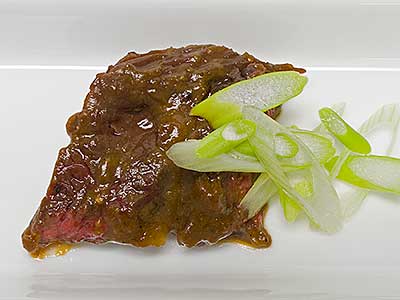April 1, 2013
Amuse-Bouche

miso-cuit steak
(miso-seared steak)
I love food hype, and I’m fascinated by the idiots that believe it. I once heard one type of food hype called the Detroit effect. Take any food item and add a city’s name to the beginning, and it will sound like a better product. That is, except if the city’s name is Detroit. Try it. We are more impressed by San Francisco sourdough bread than just plain sourdough bread. Company names can help, too. Harris Ranch beef sounds mighty impressive and exclusive if you’ve never been to Harris Ranch. And then there are the unregulated marketing terms like “free-range,” “grass-fed,” “sea salt,” “minimally-processed,” and my favorite, “all-natural.” I saw a package of “all-natural” Israeli couscous today. Last time I looked, couscous doesn’t exist in nature. There is no couscous plant.
At the 2012 World of Flavors Conference, there was a presentation on white binchotan charcoal. A special charcoal from Japan that is commonly used in certain styles of Japanese cooking, such as yakitori. We were told that binchotan charcoal burns at 900 °F (482 °C), lasts a long time, and produces no smoke. Other charcoal products burn just slightly cooler, but a few burn even hotter than binchotan charcoal. Burn time is somewhat a matter of how the charcoal is organized in the burn box and how air flows through it. Maybe this charcoal lasts longer than others. Maybe not. It has been documented as producing very little smoke, which makes it convenient for indoor use.
The price of white binchotan charcoal can range from about $7 to $12 per pound. Mesquite charcoal, my standby, is readily available for 50¢ per pound. If you’re going to be cooking over a small, traditional Japanese grill, then the form factor of binchotan charcoal will be advantageous, but I wouldn’t want to dump it into my 30-year-old Weber kettle and roast a turkey.
And the effectiveness of the hype? As I sat in the conference and looked around, I noticed that many of my fellow attendees seemed to be mesmerized by the presentation.
The next day, a dish was prepared on a small brassier filled with some binchotan charcoal. For a cooking utensil, the chef used a large leaf. It was a magnolia leaf that had been dried so it was as flat as a sheet of paper. A small piece of meat described as a piece of boneless, beef short rib was selected to be cooked. A mixture of four different misos that had been lightened with a little saké sat nearby in a bowl. The leaf was placed over the grill, a few inches above the charcoal. A piece of the meat was brushed with the miso mixture and set on the leaf. After a brief while, the miso started bubbling. In short order the meat was flipped. A little while later it was set aside to rest. When the meat was cut, the inside appeared from my vantage point to be quite rare, if not still raw. Although the chef didn’t call it “miso-seared beef,” I think that would be an appropriate name for the dish.
The crowd seemed to be fascinated by the idea of cooking meat on a leaf. I thought it was a bit gimmicky. As the chef said, the charcoal gave off infrared energy. This, I assume, heated the leaf rather than passing through it. The hot leaf heated the miso, and that in turn cooked the meat. But, maybe the leaf was transparent to the infrared? Then the energy from the charcoal heated the miso directly. The miso is mostly water, so it’s temperature couldn’t exceed 100 °C (212 °F). The 900 °F rating is the temperature at the surface of the charcoal, not at the surface of the food. The steak was essentially boiled on both sides. Boiling meat is not very exciting, but nonetheless, I decided to simulate the process at home.
Returning from the conference, as I entered my driveway, I looked up at one of the magnolia trees that line my street. Did I really want to gather leaves and try to dry them? Naw. I’d just substitute a frying pan.
I know from previous measurements that the old-fashion electric-coil hobs on my cooktop can reach surface temperatures in excess of 1000 °F (538 °C), the limit of my infrared thermometer. A quick measurement showed that I could easily, if not safely, reach 500 °F (260 °C) in a dry frying pan.
The piece of meat I had on hand was hanger steak. I cut a 60-g (2-oz) portion from the whole muscle. Rather than mix four types of miso, I chose to use just akamiso. Sometimes referred to as red miso, this is my preferred variety for flavor and lower salt content. Not having any saké open, I opted to thin the miso with a little dry white vermouth. I smeared both sides of the meat with the mixture and put it into a hot, dry frying pan. There was a lot of splattering as the water evaporated from the miso. When one side appeared to dry out, I flipped the meat over. When the second side had a similar appearance, I transferred the meat to a plate to rest for a few minutes. After resting, the meat was cut into 4 portions. Each was served with a sprinkling of thinly sliced green onions.
The meat was actually cooked a bit more than I expected. The interior was rare to medium-rare. As hanger steak can be, the meat was a tender yet chewy.
This method of cooking would be ideal for thin slices of soft muscles like the psoas major, the primary muscle of a tenderloin. That muscle is very tasty raw and would go well with a quick miso sear.
© 2013 Peter Hertzmann. All rights reserved.
